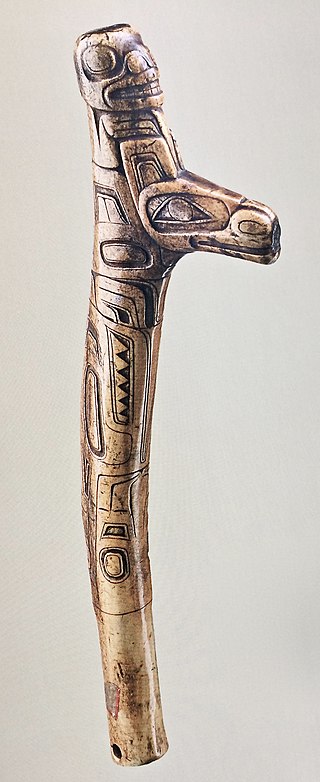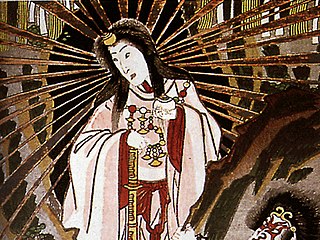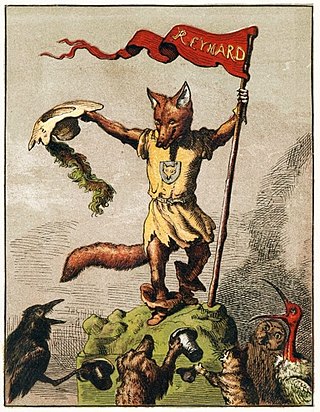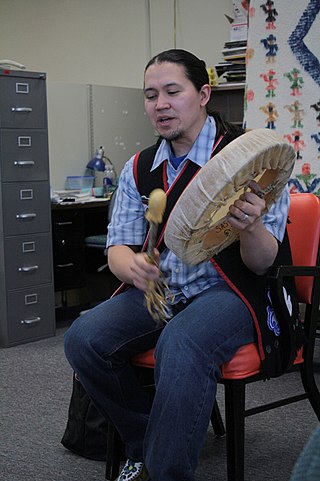Related Research Articles

Tsimshian mythology is the mythology of the Tsimshian, an Aboriginal people in Canada and a Native American tribe in the United States. The majority of Tsimshian people live in British Columbia, while others live in Alaska.
The Abenaki people are an indigenous peoples of the Americas located in the Northeastern Woodlands region. Their religious beliefs are part of the Midewiwin tradition, with ceremonies led by medicine keepers, called Medeoulin or Mdawinno.
The Haida are one of the indigenous peoples of the Pacific Northwest Coast of North America. Their national territories lie along the west coast of Canada and include parts of south east Alaska. Haida mythology is an indigenous religion that can be described as a nature religion, drawing on the natural world, seasonal patterns, events and objects for questions that the Haida pantheon provides explanations for. Haida mythology is also considered animistic for the breadth of the Haida pantheon in imbuing daily events with Sǥā'na qeda's.

Chinese mythology is mythology that has been passed down in oral form or recorded in literature in the geographic area now known as Greater China. Chinese mythology includes many varied myths from regional and cultural traditions. Much of the mythology involves exciting stories full of fantastic people and beings, the use of magical powers, often taking place in an exotic mythological place or time. Like many mythologies, Chinese mythology has in the past been believed to be, at least in part, a factual recording of history. Along with Chinese folklore, Chinese mythology forms an important part of Chinese folk religion. Many stories regarding characters and events of the distant past have a double tradition: ones which present a more historicized or euhemerized version and ones which present a more mythological version.

The Indigenous peoples of the Americas comprise numerous different cultures. Each has its own mythologies, many of which share certain themes across cultural boundaries. In North American mythologies, common themes include a close relation to nature and animals as well as belief in a Great Spirit that is conceived of in various ways.

In mythology, folklore and speculative fiction, shape-shifting is the ability to physically transform oneself through an inherently superhuman ability, divine intervention, demonic manipulation, sorcery, spells or having inherited the ability. The idea of shape-shifting is in the oldest forms of totemism and shamanism, as well as the oldest existent literature and epic poems such as the Epic of Gilgamesh and the Iliad. The concept remains a common literary device in modern fantasy, children's literature and popular culture.

Japanese mythology is a collection of traditional stories, folktales, and beliefs that emerged in the islands of the Japanese archipelago. Shinto and Buddhist traditions are the cornerstones of Japanese mythology. The history of thousands of years of contact with China and India myths are also key influences in Japanese mythology.

Nanabozho, also known as Nanabush, is a spirit in Anishinaabe aadizookaan, particularly among the Ojibwe. Nanabozho figures prominently in their storytelling, including the story of the world's creation. Nanabozho is the Ojibwe trickster figure and culture hero.
Comparative mythology is the comparison of myths from different cultures in an attempt to identify shared themes and characteristics. Comparative mythology has served a variety of academic purposes. For example, scholars have used the relationships between different myths to trace the development of religions and cultures, to propose common origins for myths from different cultures, and to support various psychoanalytical theories.

Raven Tales are the traditional human and animal creation stories of the indigenous peoples of the Pacific Northwest Coast. They are also found among Athabaskan-speaking peoples and others. Raven stories exist in nearly all of the First Nations throughout the region but are most prominent in the tales of the Haida, Tsimshian, Tlingit and Tahltan people.

Coyote is a mythological character common to many cultures of the Indigenous peoples of North America, based on the coyote animal. This character is usually male and is generally anthropomorphic, although he may have some coyote-like physical features such as fur, pointed ears, yellow eyes, a tail and blunt claws. The myths and legends which include Coyote vary widely from culture to culture.

The mythology of the Miwok Native Americans are myths of their world order, their creation stories and 'how things came to be' created. Miwok myths suggest their spiritual and philosophical world view. In several different creation stories collected from Miwok people, Coyote was seen as their ancestor and creator god, sometimes with the help of other animals, forming the earth and making people out of humble materials like feathers or twigs.
Chumash traditional narratives include myths, legends, tales, and oral histories preserved by the Chumash people of the northern and western Transverse Ranges, Santa Barbara—Ventura coast, and northern Channel Islands, in present-day Southern California.

Many references to ravens exist in world lore and literature. Most depictions allude to the appearance and behavior of the wide-ranging common raven. Because of its black plumage, croaking call, and diet of carrion, the raven is often associated with loss and ill omen. Yet, its symbolism is complex. As a talking bird, the raven also represents prophecy and insight. Ravens in stories often act as psychopomps, connecting the material world with the world of spirits.

In mythology and the study of folklore and religion, a trickster is a character in a story who exhibits a great degree of intellect or secret knowledge and uses it to play tricks or otherwise disobey normal rules and defy conventional behavior.

Alaska Native storytelling has been passed down through generations by means of oral presentation. The stories tell life lessons or serve as lessons in heritage. Many different aspects of Arctic life are incorporated into each story, mainly the various animals found in Alaska. Due to the decline in the number of speakers of native languages in Alaska and a change in lifestyle amongst many of the native peoples, oral storytelling has become less common. In recent years many of these stories have been written down, though many people argue that the telling of the story is just as important as the words within.
Coyote is an irresponsible and trouble-making character who is nevertheless one of the most important and revered characters in Navajo mythology. Even though Tó Neinilii is the Navajo god of rain, Coyote also has powers over rain. Coyote’s ceremonial name is Áłtsé hashké which means "first scolder". In Navajo tradition, Coyote appears in creation myths, teaching stories, and healing ceremonies.
Canadian folklore is the traditional material that Canadians pass down from generation to generation, either as oral literature or "by custom or practice". It includes songs, legends, jokes, rhymes, proverbs, weather lore, superstitions, and practices such as traditional food-making and craft-making. The largest bodies of folklore in Canada belong to the aboriginal and French-Canadian cultures. English-Canadian folklore and the folklore of recent immigrant groups have added to the country's folk.

The Heroes Twins are recurring characters from the mythologies of the indigenous peoples of the Americas. The specifics of each myth vary from tribe to tribe, but each story has a pair of twins who were born when their pregnant mother was killed by the tale's antagonist. Twins were considered unnatural in many cultures of this region, with beliefs about them having supernatural abilities.
References
- 1 2 3 Scott, William Henry (1964). "The Legend of Biag, an Igorot Culture Hero". Asian Folklore Studies. 23 (1): 93–110. doi:10.2307/1177639. ISSN 0385-2342. JSTOR 1177639.
- 1 2 "Encyclopedia.com | Free Online Encyclopedia". www.encyclopedia.com. Retrieved 2019-05-05.
- ↑ Long, Jerome H. (2005). "Culture Heroes". In Lindsay Jones; et al. (eds.). Encyclopedia of Religion. Vol. 3 (second ed.). Macmillan Reference USA: Thomas Gale.